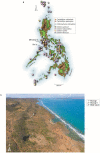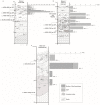The Exploitation of Toxic Fish from the Terminal Pleistocene in Maritime Southeast Asia: A Case Study from the Mindoro Archaeological Sites, Philippines
- PMID: 37443911
- PMCID: PMC10339915
- DOI: 10.3390/ani13132113
The Exploitation of Toxic Fish from the Terminal Pleistocene in Maritime Southeast Asia: A Case Study from the Mindoro Archaeological Sites, Philippines
Abstract
Representatives of the Diodontidae family (porcupinefish) are known to have been fished by prehistoric Indo-Pacific populations; however, the antiquity of the use of this family is thus far unknown. We report here on the presence of Diodontidae in the archaeological sites of Bubog I, II, and Bilat in Mindoro, Philippines, dating back to c. 13,000 BP (Before Present). This evidence demonstrates the early exploitation by islanders of poisonous fish. Every part of porcupinefish can be toxic, but the toxicity is mostly concentrated in some organs, while other parts are edible. The continuous presence of Diodontidae remains throughout the stratigraphic record of these Philippines shell middens suggests that porcupinefish were prepared by human inhabitants of the sites to render them safe for consumption, indicating an advanced cultural knowledge of the preparation needed to separate the toxic principle from the edible parts. This constitutes one of the rare examples of poison processing by humans, aside from the contentious wooden stick poison applicator from Border Cave (South Africa).
Keywords: Diodontidae; Indo-Pacific; hunter-gatherer; marine environment; poison.
Conflict of interest statement
The authors declare no conflict of interest.
Figures






References
-
- Borgia V. Chapter 1. The Prehistory of Poison Arrows. In: Wexler P., editor. Toxicology in Antiquity. 2nd ed. Academic Press; Cambridge, MA, USA: 2019. pp. 1–10. History of Toxicology and Environmental Health.
-
- Perrot E., Vogt E. Poisons de Flèches et Poisons d’Epreuve. Vigot Frères; Paris, France: 1913.
-
- Borgia V., Carlin M.G., Crezzini J. Poison, Plants and Palaeolithic Hunters. An Analytical Method to Investigate the Presence of Plant Poison on Archaeological Artefacts. Quat. Int. 2017;427:94–103. doi: 10.1016/j.quaint.2015.12.025. - DOI
-
- D’Errico F., Backwell L., Villa P., Degano I., Lucejko J.J., Bamford M.K., Higham T.F.G., Colombini M.P., Beaumont P.B. Early Evidence of San Material Culture Represented by Organic Artifacts from Border Cave, South Africa. Proc. Natl. Acad. Sci. USA. 2012;109:13214–13219. doi: 10.1073/pnas.1204213109. - DOI - PMC - PubMed
LinkOut - more resources
Full Text Sources
Research Materials

